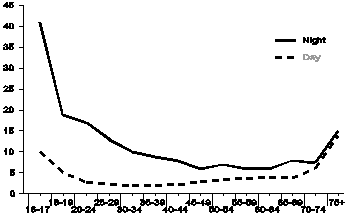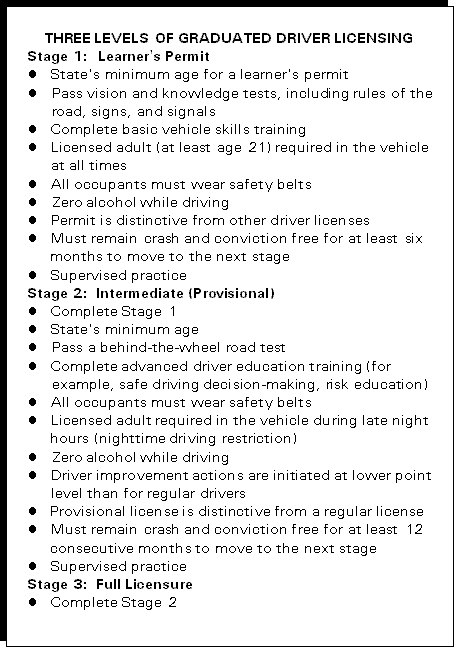















Traffic Tech #189: Saving Teenage Lives the Case for Graduate Driver Licensing |
|---|
|

SAVING TEENAGE LIVES
THE CASE FOR GRADUATED DRIVER LICENSING
Young novice drivers are over represented in crashes for many reasons, primarily a combination of immaturity, inexperience, and high-risk driving exposure. This is true for teenagers everywhere, but it is a particular problem in the United States, where more teenagers have cars or have access to a family car than in any other nation. Saving Teenage Lives, The Case for Graduated Driver Licensing is an information reference guide for legislators and public and private interest groups. The booklet demonstrates the need for a new look at how we train our young drivers. Graduated driver licensing, a three-tiered system of helping young novice drivers develop the skills and judgment necessary to operate an automobile safely, has proven to reduce crashes involving teens in states and countries that have adopted this system.

On the basis of miles driven, teenagers are involved in three times as many fatal crashes as are all drivers. Why do young drivers have such poor driving performance? Three factors work together to make the teen years so deadly for young drivers.
Inexperience
All young drivers start out with very little knowledge or understanding of the complexities of driving a motor vehicle. Like any other skill, learning to drive well takes a lot of time. Technical ability, good judgment, and experience all are needed to properly make the continuous decisions, small and large, that add up to safe driving. By making it so easy to get a driver license -- literally handing teenagers the car keys without requiring an extended period of supervised practice driving time -- we are increasing the likelihood of making a fatal mistake.
Risk taking behavior and immaturity
High crash rates are attributed to adolescents who participate in high risk behaviors such as speeding, inattention, drinking and driving, and not using a seat belt. Peer pressure also often encourages risk taking.
Greater risk exposure
Teens often drive at night with other teens in the vehicle, factors that increase crash risk. Teen drivers are different from other drivers, and their crash experience is different too. Compared to other drivers, a higher proportion of teenagers are responsible for their fatal crashes because of their own driving errors.
Graduated Licensing
With graduated driver licensing, new drivers typically go through a three-stage process that involves their gradual introduction to full driving privileges. By restricting when teenagers may drive, and who may accompany them, graduated driver licensing allows new drivers to gain much needed on-the-road experience in controlled, lower risk settings. It also means that a teenager will be a little older and more mature when he or she gains a full, unrestricted license. After the young driver demonstrates responsible driving behavior, restrictions are systematically lifted until the driver "graduates" to full driving privileges.
Graduated driver licensing combines a number of measures proven to be effective in fostering safer driving behavior in young drivers. In Ontario, Canada, and in New Zealand -- where graduated driver licensing is in effect -- crash deaths and injuries for teenage drivers have been reduced. Maryland, which has a nighttime driving restriction, and California have shown reductions in both fatal crashes and traffic violations among young drivers.
The booklet contains a Model Law for Graduated Driver Licensing prepared by the National Committee on Uniform Traffic Laws and Ordinances, descriptions of the licensing laws in many states and other countries, teenage crash statistics, and a list of resources for those who wish to upgrade their state's driver licensing laws.

HOW TO ORDER
For a copy of Saving Teenage Lives: The Case for Graduated Driver Licensing (28 pgs), write to the Media and Marketing Div., NHTSA, NTS-21, 400 Seventh Street, S.W., Washington, DC 20590, or fax (202) 493-2062, or download http://www.nhtsa.dot.gov/people/injury/newdriver
U.S. Department
of Transportation
National Highway
Traffic Safety
Administration
400 Seventh Street, S.W. NTS-31
Washington, DC 20590
Traffic Tech is a publication to disseminate
information about traffic safety programs,
including evaluations, innovative programs,
and new publications. Feel free to copy it as you wish.
If you would like to receive a copy contact:
Linda Cosgrove, Ph.D., Editor, Evaluation Staff
Traffic Safety Programs
(202) 366-2759, fax (202) 366-7096
mailto:lcosgrove@nhtsa.dot.gov
